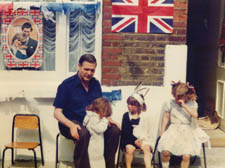|
|
 |
| |

Tears Cathcart Street’s Royal wedding party in July 1981. |
Camden Book Reviews | Kentish Town | Memories | History | Kentish Town Lives. By Kentish Town Living History Group. | Owl Bookshop
A group of Kentish Town folk have committed their memories into a living history, writes Dan Carrier
HORSES trotting through the back streets of Kentish Town pulling milkmen and coal carts, or making their way to Holmes Road where a blacksmith would see to their shoes: although such sights have disappeared from the streets today, working nags were a daily feature of life in the area in living memory.
The recollections of daily life in NW5 is the subject of new book. It is the product of the regular sessions of the Kentish Town Living History Group, whose members gather at the Torriano Meeting House. This 48-page booklet reveals a world of independent businesses and a close-knit neighbourhood.
The authors first got together in 2004 and their meetings focus on a different topic that sheds light on what life was like in Kentish Town over the years. They consider everyday chores such as shopping, transport, entertainment and how the area coped with two world wars.
History group member and book editor Michael Andrew says the collection reveals that the Kentish Town of 50 years ago is still recognisable, despite the passage of time.
He said: “I recently came across the following quote: ‘History is never dead, because it keeps on repeating itself, though never in quite the same words or on quite the same scale. The wax of human experience is always the same. It is we who put our stamp on it.
“These snippets of a number of people’s lives give us just that, in a matter-of-fact, straight-forward and honest way: how it was in a certain place at a certain time and in a certain era, simply the way things were.
“From shops to shelters, education to recreation, trains to trolley buses; whether it is on the subject of food or clothes, jobs or holidays, buildings or entertainment, their stories are told with wry humour, irony and candour. But above all, I think, told with a sense of love and affection for the memories this corner of London holds for them. The stories offer us a glimpse of ordinary people living ordinary lives and recording events and changes which make up our neighbourhood.”
Doris “Dolly” Webster recalls the role local pubs played in their community: “Pubs were social centres then,” she writes. “The regulars paid in for loan clubs and outings to Southend and Clacton. In the summers we used to go hop-picking in Kent. We loved it. The Gypsies were always there and there was dancing in the evenings.”
Georgina Brazier-Potter was a pupil at Camden School for Girls between 1949 and 1955. She recalls a school uniform with the motto “Onwards and upwards” emblazoned on the badge, with prefects wearing a green silk function dress on special occasions and regular lectures given by visiting dignitaries, including a memorable talk by the poet Edith Sitwell.
A regular feature of the mid-20th century is the role livestock played in people’s lives: Bill Butler recalls feeding the milkman’s horse with apples and the sheer size of the coalman’s shire horse. He also recalls cattle being brought into Maiden Lane’s railway sidings and walked through the streets to Market Road to be sold and slaughtered.
Kentish Town Road is remembered with delight: Irish émigré Kathy McGrath moved to the area in 1944 and recalls the huge variety of shops: “We had three big stores – London Drapery, Lennards and Daniels, plus an M&S.” She has written a comprehensive list of the shops on either side of the street in the 1950s. Many of the names will jog the memory, although only Blustons “for coats and gowns”, Woolworths and bike shop Chamberlaines still trade. Her list includes The Moreton Arms, which is now Quinns, Tom’s Junk Shop, an Express Dairy, a corset shop and the Provident Cheque Office. Dunn’s Hat Factory was still operating at the junction of Royal College Street, and there was the ABC cafeteria by Prince of Wales Road.
“The list is from memory and may not be entirely accurate,” she said. “I remember the left side better as I usually walked up that side. I don’t remember all the pub names as I didn’t go in them. I can’t remember much about the banks as it was only the rich and business people who had cheque books. There were no charity shops, fewer cafés and no bookmakers as gambling was illegal.”
Camden’s first black mayor, Gerry Williams, was given a flat by the Railway Board as he worked on the trains and recalls the “Tartan Arrow” goods express leaving the Kentish Town goods yard every night at 6pm for Scotland. He remembers working the Saturday football specials, taking Spurs and Arsenal fans to grounds all over England. He was moved from his railway home in St Pancras to a new council flat in Prince of Wales Road, and became involved in local politics, including the campaign to turn Talacre Gardens – then a bomb site – into a permanent outdoor space.
DAN CARRIER
|
 |
|
 |
 |
|
 |
|


